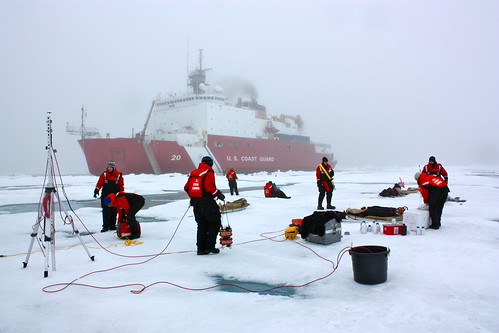氣候暖化融化北極海冰,打開了航運和石油天然氣開採的門戶。然而美國國家研究委員會(National Research Council)北極漏油應變小組23日提出警告,指出美國的人員、設備、運輸、通訊、導航和安全相關資源都尚未準備好,不足以因應北極漏油意外。
23日,國家研究委員會發表的最新報告「美國北極海洋環境漏油意外因應能力研究」認為,美國沒有基礎設備可因應漏油事件,一旦北極發生大規模漏油,美國將背負「重大責任」。
基礎資訊缺乏 意外發生難以應變
北極的極端氣候、環境限制、有限的作業和通訊設備、廣闊幅員以及脆弱的物種、生態和文化,都讓漏油意外的應變難上加難。
報告警告,「精密的海圖是北極航海和漏油應變不可或缺的資料。但是海岸線地形和水文數據幾乎都已過時,潮汐、洋流和海平面資料都很缺乏,很難得到精確的定位和標高資料。」
「美國在北極沒有船隻交通管制系統,各種任務都難以執行,包括漏油應變,而且導致過度依賴私人企業和國外系統。」
「白令海峽和大部分阿拉斯加沿岸靠私人自動辨識系統接收器追蹤船隻,但是覆蓋率很有限,因此產生許多『盲點』,讓岸上人員難以及早辨識出風險。」
綠色和平:禁止鑽油才能避免漏油意外
小組認為,北極當地必須備有空中原地燃燒漏油和除油劑設備,才能在漏油意外發生時立即反應。小組並建議,「應在美國北極領土執行嚴謹控制的漏油田野實驗,作為長期、合作性的北極漏油研究和跨地區、跨州和聯邦層級發展計畫的一部分。」
報告指出,駐守北極的美國海岸防衛隊相關資源必須增加,並且和阿拉斯加環保署合作,為當地社群發展出漏油應變訓練計畫,讓當地村莊有受過訓練的應變小組,並且結合當地對海冰、海洋和海洋生物狀況的傳統知識處理漏油事件。
由於美國北極海域相當靠近國際公海,指揮中心間的溝通協調、跨界協調規劃、人員和器材的跨領土移動、翻譯人員的需求等,都必須在發生漏油前規劃好。
綠色和平美國北極專案人員John Deans表示,「這份研究再次說明了北極鑽油的危險性。唯一能完全避免漏油的方式就是不要鑽油。」全世界近5百萬人參與綠色和平保護北極的連署,呼籲各國政府在北極周圍設立全球保護區,禁止在脆弱的北極海上鑽油和進行破壞性的商業活動。
The warming climate is melting sea ice, opening U.S. Arctic waters to shipping and oil and gas development, but the National Research Council Committee on Responding to Oil Spills in Arctic Environments warned today that U.S. personnel, equipment, transportation, communication, navigation, and safety resources are not adequate for an Arctic oil spill response.
In a new report released today, “Responding to Oil Spills in the US Arctic Marine Environment” the National Research Council calls this absence of infrastructure a “significant liability” in the event of a large oil spill.
The Arctic poses challenges to oil spill response, such as extreme weather and environmental settings, limited operations and communications infrastructure, a vast geographic area, and vulnerable species, ecosystems, and cultures.
The committee recommends that “carefully controlled field experiments that release oil in the U.S. Arctic be conducted as part of a long-term, collaborative Arctic oil spill research and development program that spans local, state, and federal levels.
It suggests that positioning response equipment such as aerial in situ burn and dispersant capabilities in the region before a spill occurs would provide immediate access to rapid response options.
The U.S. Coast Guard’s presence and performance capacity in the Arctic should be enhanced, the report recommends. The Coast Guard should work with the Alaska Department of Environmental Conservation to develop an oil spill training program for local communities and trained response teams in local villages.
They also should integrate local and traditional knowledge of ice and ocean conditions and marine life to enhance oil spill response, the report says.
Given the nearness of U.S. Arctic waters to international territories, communications between command centers, coordinated planning, trans-boundary movement of people and equipment, and identification of translators, should be addressed before an actual spill, the report says.
“High-quality nautical charting is essential for marine traffic purposes and oil spill response in the Arctic. However, shoreline topographic and hydrographic data are mostly obsolete, with limited tide, current, and water level data and very little ability to get accurate positioning and elevation,” the report warns.
“The lack of a U.S. vessel traffic monitoring system for the Arctic creates significant vulnerability for U.S. Arctic missions, including oil spill response, and creates undue reliance on private industry and foreign national systems.”
“Private AIS [Automatic Identification System] receivers are used to track vessels in the Bering Strait and along a large part of Alaska coastal areas, but there are significant gaps in coverage. Consequently, there are numerous regional ‘blind spots’ where an early indication of elevated risks may not be apparent to officials on shore,” warns the committee.
Greenpeace U.S. Arctic Campaigner John Deans commented, “This proves yet again that Arctic drilling is far too risky. The only way to prevent a spill is not to drill in the first place.”
Nearly five million people from around the world have signed the Greenpeace petition to protect the Arctic, calling on governments to create a global sanctuary around the North Pole, and to ban offshore drilling and destructive commercial activity in the fragile Arctic environment.
※ 全文及圖片詳見:ENS







